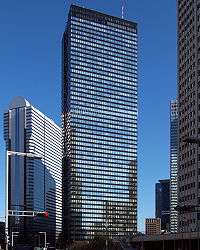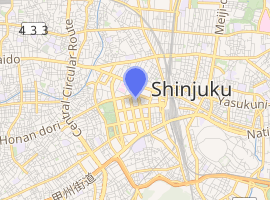Shinjuku Mitsui Building
The Shinjuku Mitsui Building (新宿三井ビル, Shinjuku Mitsui Biru) is a high-rise building in Nishi-Shinjuku, Shinjuku, Tokyo. It is owned by Mitsui Fudosan. It is one of the ten tallest buildings in Tokyo, and was the tallest building in Tokyo and Japan from September 1974 to March 1978, when Sunshine 60 was completed.[1]
| Shinjuku Mitsui Building | |
|---|---|
 Shinjuku Mitsui Building at sunset | |

| |
| General information | |
| Type | Office |
| Location | Shinjuku, Tokyo, Japan |
| Coordinates | 35.691898°N 139.693903°E |
| Construction started | 1972 |
| Completed | 1974 |
| Opening | September 1974 |
| Owner | Mitsui Fudosan |
| Height | |
| Architectural | 224.9 m (738 ft) |
| Roof | 212.1 m (696 ft) |
| Technical details | |
| Floor count | 55 |
| Floor area | 176,671 m2 (1,901,670 sq ft) |
| Design and construction | |
| Architect | Nihon Sekkei |
| Developer | Mitsui Fudosan |
| Structural engineer | Kiyoshi Mutō |
It was built in the style of high-rise buildings that were being built in the United States in the 1970s. It is notable for the black diagonal braces on its east and west facades. At the base of the skyscraper is a sunken garden and a surprisingly large plaza. In addition to the sunken garden, there is also a roof-top garden.
With its black facades, Shinjuku Mitsui Building stands out among the skyscrapers in Shinjuku. It is located next to the Shinjuku Center Building, which is two meters lower but appears to be taller because its first floor is located on higher ground. It made an appearance in the 1984 film The Return of Godzilla.
Structure

The building's height is 212 meters to the top of the roof, and 225 meters to the architectural top. Its entrance lobby is on the second floor. The X-shaped steel braces on the side of the building serve as seismic reinforcement and also as braces for the doors of the machine rooms at each end of every floor. The doors are 4–5 floors tall, for replacement of equipment such as air-conditioners. As in the older Keio Plaza Hotel, some fire escape exits are exposed outside the building to prevent smoke from accumulating in the case of fire.
In 2013, Mitsui Fudosan and Kajima Corporation began installing six massive pendulums on the roof of the building to counter long-period earthquake ground motion. The pendulums will reduce magnitude of building motion by half or more during a major earthquake, such as the Great East Japan earthquake of 2011.[2]
Tenants
Capcom has its Tokyo offices in the building.[3]
The top 55th floor was formerly occupied by a Chinese restaurant called the Mandarin Palace, but now it houses tenant offices. The 54th floor has a restaurant and a club called "Shinjuku Mitsui Club" for current and former employees of the Mitsui Group and their relatives. There is no observation deck open to the public.
Other floors occupied by tenant office space, except for the B1 to 5th floors, which house banks, restaurants, dental offices, and so on.
- B1: Ministop, Starbucks, Doutor Coffee, restaurants for Okinawan, Indian, Thai, Mandarin, and Korean cuisine
- 1st floor: Royal Host, Post office, Seiko Epson, Mitsui Fudoson Realty, Kyokuto Securities Co., Delicatessen
- 2nd floor: Sizzler, Sumitomo Mitsui Banking Corporation
- 3rd floor: Restaurants and Izakaya
- 4th-5th floors: Clinics, Dental Offices, Medical Center
- 54th floor: Shinjuku Mitsui Club
Access
- 8 minutes by foot from Shinjuku Station
- 1 minute by foot Toei Ōedo Line
- 2 minutes by foot from Tokyo Metro Marunouchi Line
- Parking: Yes (fee)
References
- "Shinjuku Mitsui Building". Skyscraper Source Media. Retrieved September 22, 2008.
- "Halving the Shaking Due to Long-Period Earthquake Ground Motion at Shinjuku Mitsui Building". Mitsui Fudosan Co., Ltd., Kajima Corporation. Retrieved 4 April 2015.
- "Locations." Capcom. Retrieved on August 12, 2011. "Shinjuku Mitsui Building 2-1-1 Nishi Shinjuku, Shinjuku-ku, Tokyo"
External links
![]()
| Records | ||
|---|---|---|
| Preceded by Shinjuku Sumitomo Building |
Tallest building in Japan 225 m (738 ft) 1974–1978 |
Succeeded by Sunshine 60 |
| Tallest building in Tokyo 225 m (738 ft) 1974–1978 | ||